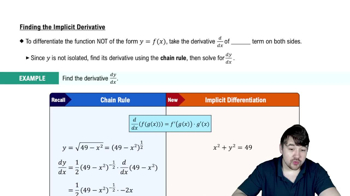Table of contents
- 0. Functions7h 52m
- Introduction to Functions16m
- Piecewise Functions10m
- Properties of Functions9m
- Common Functions1h 8m
- Transformations5m
- Combining Functions27m
- Exponent rules32m
- Exponential Functions28m
- Logarithmic Functions24m
- Properties of Logarithms34m
- Exponential & Logarithmic Equations35m
- Introduction to Trigonometric Functions38m
- Graphs of Trigonometric Functions44m
- Trigonometric Identities47m
- Inverse Trigonometric Functions48m
- 1. Limits and Continuity2h 2m
- 2. Intro to Derivatives1h 33m
- 3. Techniques of Differentiation3h 18m
- 4. Applications of Derivatives2h 38m
- 5. Graphical Applications of Derivatives6h 2m
- 6. Derivatives of Inverse, Exponential, & Logarithmic Functions2h 37m
- 7. Antiderivatives & Indefinite Integrals1h 26m
- 8. Definite Integrals3h 25m
4. Applications of Derivatives
Implicit Differentiation
Problem 3.R.58
Textbook Question
Evaluate and simplify y'.
sin x cos(y−1) = 1/2
 Verified step by step guidance
Verified step by step guidance1
Start by isolating y' on one side of the equation. To do this, divide both sides by sin(x) cos(y - 1). This gives you y' = (1/2) / (sin(x) cos(y - 1)).
Recognize that y' represents the derivative of y with respect to x, which can be expressed as dy/dx. Rewrite the equation as dy/dx = (1/2) / (sin(x) cos(y - 1)).
To solve this differential equation, separate the variables by moving all terms involving y to one side and all terms involving x to the other side. This will involve multiplying both sides by cos(y - 1) and dx.
Integrate both sides of the equation. The left side will involve integrating with respect to y, and the right side will involve integrating with respect to x. Remember to include the constant of integration.
After integrating, solve for y in terms of x if possible, or express the solution in an implicit form if necessary.
Recommended similar problem, with video answer:
 Verified Solution
Verified SolutionThis video solution was recommended by our tutors as helpful for the problem above
Video duration:
4mPlay a video:
Was this helpful?

 5:14m
5:14mWatch next
Master Finding The Implicit Derivative with a bite sized video explanation from Nick
Start learningRelated Videos
Related Practice



